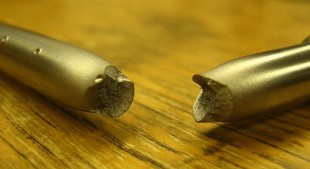Professor John Knott FRS revisits some of his favourite papers from the field of fracture mechanics.

To celebrate 350 years of scientific publishing, we are inviting our readers to tell us about their favourite papers from the Royal Society archive. Today John Knott FRS, Professor of Metallurgy and Materials at the University of Birmingham, tells us about a driving force in the field of fracture mechanics.
For anyone working in the field of the fracture of solids, or the field of structural integrity, this paper by A.A. Griffith in Philosophical Transactions A is the paper from which derive all attempts to quantify the fracture strengths of real materials. Griffith was studying the strength of glass, and, in doing so, invoked the concept of inherent flaws in the material: what came to be referred to as “Griffith cracks”. He produced an analysis for the fracture strength of a body containing such a crack, based on the balance between the release of elastic strain (or potential) energy from the stressed system versus the requirement to create two free surfaces, each having surface energy, γ.
Over the succeeding 94 years, Griffith’s paper has provided the basis for literally thousands of further publications in both basic science and practical engineering applications, leading: on the one hand, to considerations of how a material fractures ahead of an infinitesimally sharp crack; on the other, to the development of fracture mechanics and to methodologies to assess the integrity of engineering structures. (A description of the main features of these, for steel structures, is included in my own paper in the recent Philosophical Transactions A issue on ‘Fracturing across the multi-scales of diverse materials‘. The issue also describes the application of Griffith’s original work to a wide variety of other materials).

Many significant developments contributing to our understanding of brittle fracture have appeared as papers in Philosophical Transactions or in Proceedings of the Royal Society. A sample of these includes: Obreimoff (1930), Eshelby (1951), Cottrell’s Bakerian Lecture (1963), Smith (1965), the report on the 1964 Discussion Meeting “Mechanisms of Failure of Large Structures” (1965), Marsh (1964) and the report of the Meeting on Fracture (1981). Classical papers on brittle fracture ahead of, or dislocation emission from, a sharp crack are those of Kelly, Tyson and Cottrell (1967) and Rice and Thomson (1974), both in Philosophical Magazine.
The application to engineering structural integrity assessment was pioneered by Irwin, in the USA, who utilized the crack-tip stress analyses of Westergaard to provide a much more tractable method (that of “virtual work”) to calculate the change in stored energy for infinitesimal crack extension. This was followed by the work of Rice, who developed the “J-integral” to characterize the onset of fracture. In practical applications, this allows measurements of fracture toughness to be made on test-pieces that are not unrealistically large, and such values of fracture toughness are now routinely included in assessment procedures. (An alternative approach is described by Wells in the 1964 Discussion Meeting.) Such assessments underpin the safety of large-scale engineering structures in shipping, bridges, chemical plant, aerospace and nuclear power generation: all emanating from Griffith’s paper in 1921.
In 1993 I gave the Honour Lecture at the 8th International Conference on Fracture, held in Kiev. In my lecture, entitled “The Science and Engineering of Fracture”, I acclaimed Irwin as the “Father of Fracture Mechanics” and Griffith as “The Grandfather of Fracture Mechanics”. I rest my case.
